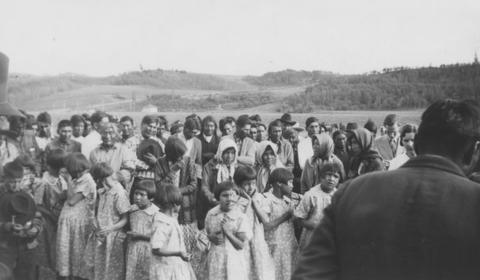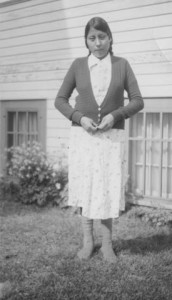
Ok, I know I’ve been speaking a lot about archival silences lately, but bear with me!
In “Reading Colonial Records Through an Archival Lens,” Bastian assures archivists that there is hope “in face of the elitism, complicity, and narrowness of the colonial record” (278). While recognizing that silences are inherent in the creation and management of sources, Bastian emphasizes the need to identify the socio-historical context of a record and to expand our definition of records to encompass radical forms such as memory texts and embodied performance. Most importantly, she writes, “framing records within social provenance and a ‘community of records’ helps to locate all voices within the spaces of records” (267). Bastian’s discussion of provenance prompts archivists to seek out the multiple relationships of creation surrounding a record.
Beverley Brown’s photo collection nicely illustrates and complicates Bastian’s claim. Reading the archival description, I was surprised to uncover that these photos were taken by “Beverley Brown, her friends, and school supervisors.” This fact can be interpreted in multiple ways. On one hand, it can be read as an inversion of subaltern theory. Post-colonialism is all about uncovering the voice of the marginalised in the fault lines and interstices of official history, however, here we find the reverse: in a satisfying poetic justice of sorts, it is within the fonds of a residential school survivor that we find the traces of the dominant discourse, subsumed under the voice of Beverley Brown. Bastian begins with a reference to the old cliché, “history is written by the winners,” yet here it is the victim, not the victor, who survives to tell her tale after years of oppression. On the other hand, it can be argued that, although Brown represents ostensibly the subaltern voice, her message is still mediated and contaminated by the hegemony. Hence, Spivak would probably agree again that once again, that there is “no ‘real Rani’ to be found” (Spivak 271).

“Lily Wildman, Mrs. Staley’s help at manse.” Telfer is mostly able to identify her subjects by name. (Item a034661)
In the quest to “locate all voices within the spaces of records” (267), Bastian quotes Ballantyne on the need to “appreciate how our colonial archives were constructed… and to reconstruct the ideological work that they have done” (276). Colonialism allows us “to analyze multi-class, multi-ethnic societies that were simultaneously co-dependent” and stratified” (269). Turning to the context of Indian Residential Schools, I sense that there is as much of an archival silence regarding native children pre-TRC as there are regarding school supervisors post-TRC. Journals and diaries of school supervisors we have and do quote much, but what are the thoughts and responses of the surviving clergy members and institutional managers in the present? While the government has actively sought to record (and contentiously retain) the oral testimonies of res school survivors, there has not been much of an effort to hear from the perpetrators as individuals. Perhaps there were, and these were unsuccessful. Here we find yet another face of archival silence–that of the colonizer in the postcolonial era. After all, nobody likes to play the criminal. For this reason, Jean Telfer’s decision to donate her collection to the MOA in the two years before her death, I find, is incredibly courageous. Her act of contributing to the ‘total archive’ necessitated a public recognition of her involvement as teacher at the Morley and Alberni residential schools. Her fonds include the names of students. While we must still, of course, remain cognizant of the biases and prejudices embedded in every individual’s subjective self-representation, I daresay Telfer’s view of residential schools must have shifted dramatically for her to speak so bravely into this archival silence.
Works Cited:
Bastian, Jeannette Allis. “Reading Colonial Records Through an Archival Lens: The Provenance of Place, Space and Creation.” Archival Science 6 (2006): 267–284.
“Beverley Brown Fonds.” Audrey and Harry Hawthorn Library and Archives. Museum of Anthropology. Web. 11 Mar. 2016.
“Jean Telfer Fonds.” Audrey and Harry Hawthorn Library and Archives. Museum of Anthropology. Web. 11 Mar. 2016.
Spivak, Gayatri (1985). The Rani of Sirmur: An Essay in Reading the Archives. History and Theory 24 (3):247-272. http://www.cameronius.com/helen/rhprg/Spivak%20the%20Rani%20of%20Sirmur.pdf
Hi Beatrice!
I’m glad you had the chance to look at the Beverly Brown fonds and see the complicating aspects in which her photographs relate to this week’s readings. However, I’m not so sure these photographs provide us with “traces of the dominant discourse” in such a small degree as a “trace”. While these photographs are mostly taken by Brown herself, the context they give is deeply tied to the dominant colonial discourse: they are in a residential school after all. These candid photographs certainly convey a competing narrative to the colonial depiction of First Nations groups as conquered or victims, but unfortunately, many of the images document their assimilation into European culture. You were right to bring in the reference to Spivak!
I think you’ve also highlighted an importance bias when it comes reading these survivor narratives almost exclusively in the TRC. Of course, their intent is to “reconcile”, but I’ve also wondered whether in the efforts to justify those who’ve been abused, other contextual information is also being repressed. Its perhaps now time to let the individual survivor narratives speak, but soon, in order to fully reconcile, all narratives should be heard on an equal front. This is the task of the post-colonial archives…I’m just skeptical whether the institutional museum archive is the place for this to occur.